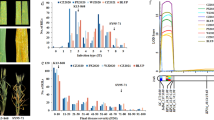Abstract
One single pathogen Fusarium graminearum Schw. was inoculated to maize inbred lines 1,145 (Resistant) and Y331 (Susceptive), and their progenies of F1, F2 and BC1F1 populations. Field statistical data revealed that all of the F1 individuals were resistant to the disease and that the ratio of resistant plants to susceptive plants was 3:1 in the F2 population, and 1:1 in the BC1F1 population. The results revealed that a single dominant gene controls the resistance to F. graminearum Schw.. The resistant gene to F. graminearum Schw. was denominated as Rfg1 according to the standard principle of the nomenclature of the plant disease resistant genes. RAPD (randomly amplified polymorphic DNA) combined with BSA (bulked segregant analysis) analysis was carried out in the developed F2 and BC1F1 populations, respectively. Three RAPD products screened from the RAPD analysis with 820 Operon 10-mer primers showed the linkage relation with the resistant gene Rfg1. The three RAPD amplification products (OPD-201000, OPA-041100 and OPY-04900) were cloned and their copy numbers were determined. The results indicated that only OPY-04900 was a single-copy sequence. Then, OPY-04900 was used as a probe to map the Rfg1 gene with a RIL F7 mapping population provided by Henry Nguyen, which was developed from the cross “S3×Mo17”. Rfg1 was primarily mapped on chromosome 6 between the two linked markers OPY-04900 and umc21 (Bin 6.04–6.05). In order to confirm the primary mapping result, 25 SSR (simple sequence repeat) markers and six RFLP (restriction fragment length polymorphism) markers in the Rfg1 gene-encompassing region were selected, and their linkage relation with Rfg1 was analyzed in our F2 population. Results indicated that SSR marker mmc0241 and RFLP marker bnl3.03 are flanking the Rfg1 gene with a genetic distance of 3.0 cM and 2.0 cM, respectively. This is the first time to name and to map a single resistant gene of maize stalk rot through a single pathogen inoculation and molecular marker analysis.







Similar content being viewed by others
References
Chen SJ, Song TM (1999) Disease resistance of maize stalk rot. Simple genetics controlled by a single gene. Acta China Agric University 4:56
Chiang HC, Wilcoxson RD (1961) Interactions of the European corn borer and stalk rot in corn. J Econ Entomol 54:850-852
Dodd JL (1980) The role of plant stresses in development of corn stalk rots. Plant Dis 64:533–537
Lander ES, Green P, Abrahamson J, Barlow A, Daly MJ, Lincoln SE, Etoh T (1987) MAPMAKER: an interactive computer package for constructing primary genetic linkage maps of experimental and natural populations. Genomics 1:174–181
McCouch SR, Kochert G, Yu ZH, Wang ZY, Khush GS, Coffman WR, Tanksley SD (1988) Molecular mapping of rice chromosomes. Theor Appl Genet 76:815–829
Michelmore RW, Paran I, Kesseli V (1991) Identification of markers linked to disease resistance genes by bulked segregant analysis: a rapid method to detect markers in a specific genomic region by using segregating populations. Proc Natl Acad Sci USA 88:9828–9832
Mims CW, Vaillancourt LJ (2002) Ultrastructural characterization of infection and colonization of maize leaves by Colletotrichum graminicola, and by a C. graminicola pathogenicity mutant. Phytopathology 92:803–812
Munkvold GP, Hellmich RL, Showers WB (1997) Reduced Fusarium ear rot and symptomless infection in kernels of maize genetically engineered for European corn borer resistance. Phytopathology 87:1071–1077
Pe ME, Gianfranceshi L, Taramino G, Tarchini R, Angelini P, Dani M, Binelli G (1993) Mapping quantitative trait loci (QTLs) for resistance to Gibberella zeae infection in maize. Mol Gen Genet 241:11–16
Sambrook J, Fritsch EF, Maniatis T (2001) Molecular cloning: a laboratory manual, Chapter 6, 3rd edn. Cold Spring Harbor Laboratory Press, New York, 2001
Smeltzer DG (1958) Relationship between Fusarium ear rot and corn earworm infestation. Agron J 50:53–55
Sobek EA, Munkvold GP (1999) European corn-borer (Lepidoptera: Pyralidae) larvae as vectors of Fusarium moniliforme, causing kernel rot and symptomless infection of maize kernels. J Econ Entomol 92: 503–509
Stack J (1999) Common stalk rot disease of corn. Plant Dis 6: 1–8
Toman J, White DG (1993) Inheritance of resistance to anthracnise stalk rot of corn. Phytopathology 83: 981–986
Wang B, Zhang CL, Weng ML (1999) Obtaining of the specific SCAR marker in maize inbred line 8112. High Tech Commun Lett 9:45–47
Wang XM, Zhu XY, Lin HX (1997) Study on the technique of isolation and pathogenicity of the maize stalk rot pathogens. Acta Phytopathol Sinica 27:29–35
Yang DE, Chen SJ, Wang YG (2001) Genetic analysis of resistance to stalk rot (caused by Pythium inflatum Mattews) in maize. China Acta Phytopathol 28:392–396
Yang DE, Zhang CL, Wang YG (2002) Review of maize stalk rot in China. J Maize Sci 1:4
Acknowledgements
This work was supported by the Natural Science Foundation Project of China (39893350) and the State High-Tech Program of China (2001AA211111). The maize RFLP probes were kindly provided by Professor Ed Coe, University of Missouri, USA. The strain of F. graminearum Schw. was kindly given by Professor Wang Xiao-Ming, The Chinese Academy of Agricultural Sciences. All maize seeds were gifted by Professor Song Tong-Ming, China Agricultural University.
Author information
Authors and Affiliations
Corresponding author
Additional information
Communicated by H.F. Linskens
Rights and permissions
About this article
Cite this article
Yang, D.E., Zhang, C.L., Zhang, D.S. et al. Genetic analysis and molecular mapping of maize (Zea mays L.) stalk rot resistant gene Rfg1. Theor Appl Genet 108, 706–711 (2004). https://doi.org/10.1007/s00122-003-1466-y
Received:
Accepted:
Published:
Issue Date:
DOI: https://doi.org/10.1007/s00122-003-1466-y




